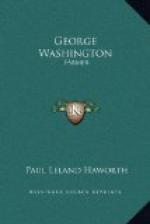Of outdoor sports he seems to have enjoyed hunting most. He probably had many unrecorded experiences with deer and turkeys when a surveyor and when in command upon the western border, but his main hunting adventure after big game took place on his trip to the Ohio in 1770. Though the party was on the move most of the time and was looking for rich land rather than for wild animals, they nevertheless took some hunts.
On October twenty-second, in descending the stretch of the Ohio near the mouth of Little Beaver Creek and above the Mingo Town, they saw many wild geese and several kinds of duck and “killed five wild turkeys.” Three days later they “saw innumerable quantities of turkeys, and many deer watering and browsing on the shore side, some of which we killed.”
He does not say whether they shot this game from the canoe or not, but probably on sighting the game they would put to shore and then one or more would steal up on the quarry. Their success was probably increased by the fact that they had two Indians with them.
Few people are aware of the fact that what is now West Virginia and Ohio then contained many buffaloes. Below the mouth of the Great Hockhocking the voyagers came upon a camp of Indians, the chief of which, an old friend who had accompanied him to warn out the French in 1753, gave Washington “a quarter of very fine buffalo.” A creek near the camp, according to the Indians, was an especial resort for these great beasts.
Fourteen miles up the Great Kanawha the travelers took a day off and “went a hunting; killed five buffaloes and wounded some others, three deer, &c. This country abounds in buffaloes and wild game of all kinds; as also in all kinds of wild fowls, there being in the bottoms a great many small grassy ponds, or lakes, which are full of swans, geese, and ducks of different kinds.”
How many of the buffaloes fell to his gun Washington does not record, but it is safe to assume that he had at least some shots at them. And beyond question he helped to devour the delicious buffalo humps, these being, with the flesh of the bighorn sheep, the ne plus ultra of American big game delicacies.
The region in which these events took place was also notable for its big trees. Near the mouth of the Kanawha they “met with a sycamore about sixty yards from the river of a most extraordinary size, it measuring, three feet from the ground, forty-five feet round [almost fifteen feet through], lacking two inches; and not fifty yards from it was another, thirty-one feet round.”
When at home, Washington now and then took a gun and went out after ducks, “hairs,” wild turkeys and other game, and occasionally he records fair bags of mallards, teal, bald faces and “blew wings,” one of the best being that of February 18, 1768, when he “went a ducking between breakfast and dinner & killed 2 mallards & 5 bald faces.” It is doubtful whether he was at all an expert shot. In fact, he much preferred chasing the fox with dogs to hunting with a gun.




